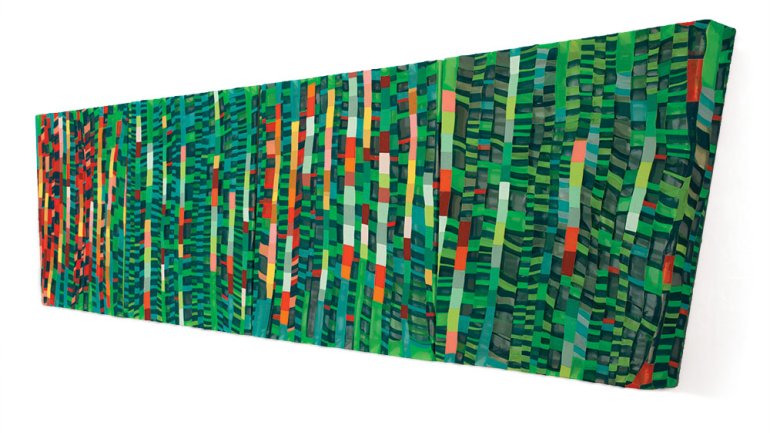50 Shades Of Chiffon
50 Shades Of Chiffon
“Yellow makes my heart flutter.” For Jen Pack, color is as much kinesthetic as aesthetic. She feels it, almost as if she had synesthesia, the neurological condition in which people report “seeing” sound and “hearing” colors. Some might call her work sculpture, while others admire it as vibrant piecework; she sees it as fabric collage and threadwork. But above all it is a tactile, three-dimensional expression of the intense way she experiences color.
Like her work, Pack defies categorization. She was born in 1976 in Astoria, Oregon. Her father comes from Korea, while her mother traces her roots back to the Mayflower; in Oregon most people thought of her as Korean, but when her family moved to Korea when she was 6, she appeared so foreign that people pointed at her, stared, and called out “Migug, migug” (“American, American”). Returning to the United States after a year, the family moved to the Portland suburb of Beaverton, Oregon, then to
San Diego when Pack entered fourth grade.
It’s characteristic of the artist that she recalls the transition in color and texture. “It was actually more of a culture shock moving to San Diego than to Korea,” she says. “Everyone was wearing those bright [translucent plastic] jelly shoes and bracelets, neon, and spandex. We were running around in corduroys and flannel shirts.”
One of five sisters, she was the tomboy. Her mother made some of the family’s clothing (including “my favorite pair of purple corduroy overalls I wore almost every day,” she says). Pack was the only one of the sisters whose interest in sewing didn’t appear until later. More inspired by her father’s work as a general contractor, which included building the family home, she preferred to make things out of wood scraps. When sixth grade rolled around, she rejected the usual home economics class in favor of woodshop; she still uses the skills she learned then to build the underlying structures for her pieces.
Her exceptional color intuition drew attention from a young age; one art teacher called home to tell her mother she must always keep Pack in art classes (which she did). And, Pack says, her mother “let us run wild with it. She even let us draw with crayons on the walls at our house.” The portfolio Pack developed during high school led to her admission to Art Center College of Design in Pasadena.
Pack was partway through her degree in fine arts when a neighbor gave her an old Adler sewing machine from the 1940s. The college had no fiber arts department, but she was smitten with the machine and began experimenting with fabric as part of her schoolwork. Then she discovered LA’s garment district. “It’s downtown, and it’s blocks and blocks of fabric shops. It’s like a candy store,” she recalls. She was so taken by the sparkling, light-catching properties of the chiffon she found there that she bought a myriad of colors to piece together, not knowing that chiffon is one of the most difficult fabrics to sew because of its shifting, slippery fibers and weave.
Ultimately, however, despite its challenges, chiffon proved to be the perfect material. No other fabric can produce the watercolor-wash effects of its distinct thread structure, particularly when several layers mount up in the seam allowances.
Over time Pack, now living in Durango, Colorado, has developed two major bodies of work in chiffon: The Color Field Works, which focus on color collage, and the Thread Works, which emphasize surface threads continuing beyond the plane of the main structure. Both incorporate layer upon layer of tonality and unexpected contrasts of hue – taking the viewer into an extraordinary realm where color and feeling become one.
Rachel Schalet Crabb is a writer and fiber artist in Minneapolis.

